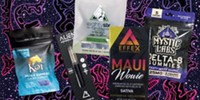Advertisement
Grab your lab coat. Let's get started
Welcome!
Welcome!
Create an account below to get 6 C&EN articles per month, receive newsletters and more - all free.
It seems this is your first time logging in online. Please enter the following information to continue.
As an ACS member you automatically get access to this site. All we need is few more details to create your reading experience.
Not you? Sign in with a different account.
Not you? Sign in with a different account.
ERROR 1
ERROR 1
ERROR 2
ERROR 2
ERROR 2
ERROR 2
ERROR 2
Password and Confirm password must match.
If you have an ACS member number, please enter it here so we can link this account to your membership. (optional)
ERROR 2
ACS values your privacy. By submitting your information, you are gaining access to C&EN and subscribing to our weekly newsletter. We use the information you provide to make your reading experience better, and we will never sell your data to third party members.
Food
Newscripts
Drinking science: Deuterated ethanol and biochemical booze mimics
by Craig Bettenhausen
September 18, 2021
| A version of this story appeared in
Volume 99, Issue 34
Putting the D in drinking

Ethanol gets the blame for hangovers and alcohol-related organ damage, but the main chemical culprit is a different molecule. As a first step in metabolizing ethanol, the body uses a liver enzyme called alcohol dehydrogenase to convert it to acetaldehyde, which is toxic.“That acetaldehyde is a very bad actor,” medicinal chemist Tony Czarnik tells Newscripts. “It cross-links your proteins, and that results in immune responses” that can cause inflammation, cirrhosis of the liver, esophageal cancer, and other ill effects.
Another enzyme, aldehyde dehydrogenase, comes along next and converts acetaldehyde to acetate, a relatively harmless molecule that the body can burn as fuel.
The problem is that acetaldehyde can accumulate in between those two enzyme-catalyzed steps, especially when heavy drinking swamps the whole alcohol-metabolizing system. Some people also have genetic factors that decrease the reaction rate or prevalence of aldehyde dehydrogenase. “That kind of got me thinking that if I can slow the rate of that first step, I can decrease the concentration of acetaldehyde present in your body at any given time,” Czarnik says. He immediately thought that deuterated ethanol might do the trick.
Czarnik’s recent research has focused on the medical applications of the kinetic isotope effect, which is when a heavier isotope slows chemical transformations relative to a lighter isotope. You see an effect only when the heavy isotope is involved in the rate-determining step of a reaction.
So Czarnik investigated both enzymes and found that placing deuterium, also known as heavy hydrogen, on the closest carbon to the OH group in ethanol causes alcohol dehydrogenase to work 4.5 times as slowly as it does on normal ethanol, a strong kinetic isotope effect. Aldehyde dehydrogenase, happily, shows no rate change.
Newscripts can’t endorse Czarnik’s next experiment, but on two separate days he mixed and drank a “very large” cocktail—a screwdriver, to be precise. The two cocktails were identical except that one used what he calls ethanol-D. He says the hangover from his ethanol-D screwdriver was much milder than the one from the regular drink. That finding gave him the confidence to try to share ethanol-D with the world.
Since then, the company he founded in 2009 to commercialize ethanol-D, Deuteria Beverages, has received patents on making ethanol-D at tanker-truck scale and on using it to reduce the negative effects of alcohol consumption. His company is also working on another, cheaper way to make deuterated ethanol. After all, that first screwdriver cost around $5,000, Czarnik says.
It’s a gutsy idea for a company, but Czarnik is no stranger to starting a science business: he cofounded the gene-sequencing tech firm Illumina and worked at other successful start-ups. Czarnik says that multiple large beer, wine, and spirits companies have expressed interest in working with Deuteria if he can get ethanol-D approved by regulators somewhere in the world.
Getting that first approval is no small task, but Czarnik is undaunted, having done a similar lift with deuterated medicines. “We’re going to be putting into the marketplace the first foodstuff that is deuterium enriched. So that’s definitely out of the box.”
Going after GABA
Another approach would be to sidestep ethanol altogether. All the fun effects of alcohol, according to psychiatrist and neuropsychopharmacologist David Nutt, come from its interactions with the neurotransmitter γ-aminobutyric acid, better known as GABA.
Nutt has dedicated his career, including stints in government service in the US and the UK, to reducing intoxicants’ harmful effects on individuals and society. His latest effort is a suite of ingredients that act directly on human GABA receptors, inducing the sociability and euphoria of booze without actually containing alcohol.
The first product, Sentia, is packaged like a whiskey and is already available in the UK and parts of Europe. For that drink, Nutt’s company found food-grade botanical extracts that modulate GABA. He and his team are now working on a set of three synthetic molecules called Alcarelle that more precisely target sites on GABA receptors, giving the molecules the potency to be sold as concentrates. “We know what our molecular template is, we know what our molecular target is pharmacologically, and we’re in the process of finalizing our chemical series” in preparation for safety testing in early 2022, Nutt says.
“If you look at toxicological safety data, there is no safe level of alcohol,” Nutt tells Newscripts. “If we could reduce that risk by finding an alternative, something that will allow people to really enjoy the same social experiences with alcohol but with significantly reduced risks, then that’s got to be beneficial to the world.”
Please send comments and suggestions to newscripts@acs.org.





Join the conversation
Contact the reporter
Submit a Letter to the Editor for publication
Engage with us on Twitter